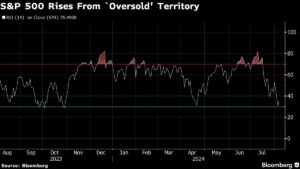Super Micro Computer Announces 10-for-1 Stock Split. Here’s What Investors Need to Know.

Recent advancements in the field of artificial intelligence (AI) sparked a flurry of interest from consumers and investors alike. The dawn of generative AI early last year has also had an impact on companies at the cutting edge of the technology, sending sales and profits to new heights. This, in turn, has sent the stock prices of these companies surging as investors scramble to get in on the ground floor of the paradigm shift in the technology landscape. Nowhere is this more evident than Super Micro Computer (NASDAQ: SMCI), also called Supermicro, which supplies servers with the computational horsepower needed for AI.
The company’s robust operating performance and consistent execution have driven its stock into the stratosphere. Since the start of 2023, Supermicro shares have gained a staggering 650%, making it one of the market’s top performers. Fueling its rise has been triple-digit gains in both revenue and profits, thanks to the insatiable demand for the hardware needed to process AI. Furthermore, since its IPO in mid-2007, the stock has soared from an $8 offering price to nearly $617 per share as of Tuesday’s market close, representing gains of 7,612%.
On Tuesday, in conjunction with its quarterly financial results, Supermicro announced plans to split its stock for the first time ever. This announcement is sparking renewed interest in this AI player. Let’s review the details of the upcoming stock split and what it means for investors.

The fine print
Supermicro announced in a regulatory filing that its board of directors had approved a 10-for-1 forward stock split. This will be “effected through an amendment to the company’s Amended and Restated Certificate of Incorporation,” which “will effect in a proportionate increase of the number of shares of authorized common stock.”
As a result of this split, shareholders will receive nine additional shares of stock for each share they own after the market closes on Monday, Sept. 30. The stock is expected to begin trading on a split-adjusted basis on Tuesday, Oct. 1.
As is customary, Supermicro shareholders won’t need to take any action to obtain the additional shares of stock. Brokerage houses and investment banks will handle the transaction behind the scenes, and the additional shares will show up in investor accounts. It’s important to note that the process varies from brokerage to brokerage, as can the timing, so the additional shares of stock may not appear immediately on Oct. 1, as it can take hours or days for the newly minted shares to appear.
An illustration can help provide much-needed context to the stock split process. For each share of Supermicro stock a shareholder holds — currently trading for roughly $620 per share (as of this writing) — post-split, investors will own 10 shares worth $62 each.
Does a stock split even matter?
As illustrated by the above example, the total value of an investor’s ownership in the company won’t change as a result of a stock split. For example, it doesn’t matter if you have a dollar bill or four quarters, as it represents the same amount of money. Similarly, Supermicro stockholders will have a greater number of shares at a proportionately lower price.
While there’s no change in the underlying ownership, a stock split tends to boost sentiment among shareholders. This is due in part to investor psychology, as the action represents a vote of confidence from the company’s management that the stock price gains are poised to continue.
There is also some indication that lower stock prices can attract a new cadre of investors, increasing demand for the new, lower-priced shares. While there’s anecdotal evidence to support that contention, once the excitement regarding the stock split dies down, investor focus shifts to the company’s business and financial performance, as this will ultimately drive future gains or losses in the stock price.
Is Supermicro stock a buy?
While the stock split itself isn’t a sufficient reason to buy Supermicro, the company’s track record of performance provides plenty of evidence that the server specialist is a buy, but there are also some things that bear watching.
In its fiscal 2024 fourth quarter (ended June 30), Supermicro reported record revenue of $5.31 billion, up 143% year over year and 38% sequentially. This drove adjusted earnings per share (EPS) of $6.25, up 78%. For context, analysts’ consensus estimates were calling for revenue of $5.3 billion and EPS of $8.07, so while sales came in ahead of expectations, profits fell far short.
CEO Charles Liang noted on the earnings conference call that the shortfall was the result of a shortage of certain server components that pushed out roughly $800 million in sales to the first quarter, as well as a change in the product mix. He went on to say that the production facility coming online in Malaysia later this year will be “instrumental in increasing our profitability.” This seems to suggest that management views the pressure on its profit margins as short-lived. If that turns out not to be the case, investors should exercise care.
It’s still early days for the adoption of generative AI, which is ultimately driving demand. The worldwide AI market was estimated at $2.4 trillion in 2023 and is expected to soar to $30.1 trillion by 2032, a compound annual growth rate of 32%, according to Expert Market Research. If Supermicro continues its long track record of execution, it will be well positioned to grab its share of the resulting windfall.
As such, investors shouldn’t buy Supermicro shares based solely on its looming stock split. Rather, it’s the company’s long history of operational excellence, blistering stock price gains, and robust financial performance that makes Supermicro stock a winning investment.
Furthermore, at less than 2 times forward sales, Supermicro is the very definition of an attractively priced stock, particularly given the vast opportunity ahead.
That’s why Super Micro Computer stock is a buy.
Should you invest $1,000 in Super Micro Computer right now?
Before you buy stock in Super Micro Computer, consider this:
The Motley Fool Stock Advisor analyst team just identified what they believe are the 10 best stocks for investors to buy now… and Super Micro Computer wasn’t one of them. The 10 stocks that made the cut could produce monster returns in the coming years.
Consider when Nvidia made this list on April 15, 2005… if you invested $1,000 at the time of our recommendation, you’d have $615,516!*
Stock Advisor provides investors with an easy-to-follow blueprint for success, including guidance on building a portfolio, regular updates from analysts, and two new stock picks each month. The Stock Advisor service has more than quadrupled the return of S&P 500 since 2002*.
*Stock Advisor returns as of August 6, 2024
Danny Vena has positions in Super Micro Computer. The Motley Fool has no position in any of the stocks mentioned. The Motley Fool has a disclosure policy.
Super Micro Computer Announces 10-for-1 Stock Split. Here’s What Investors Need to Know. was originally published by The Motley Fool








